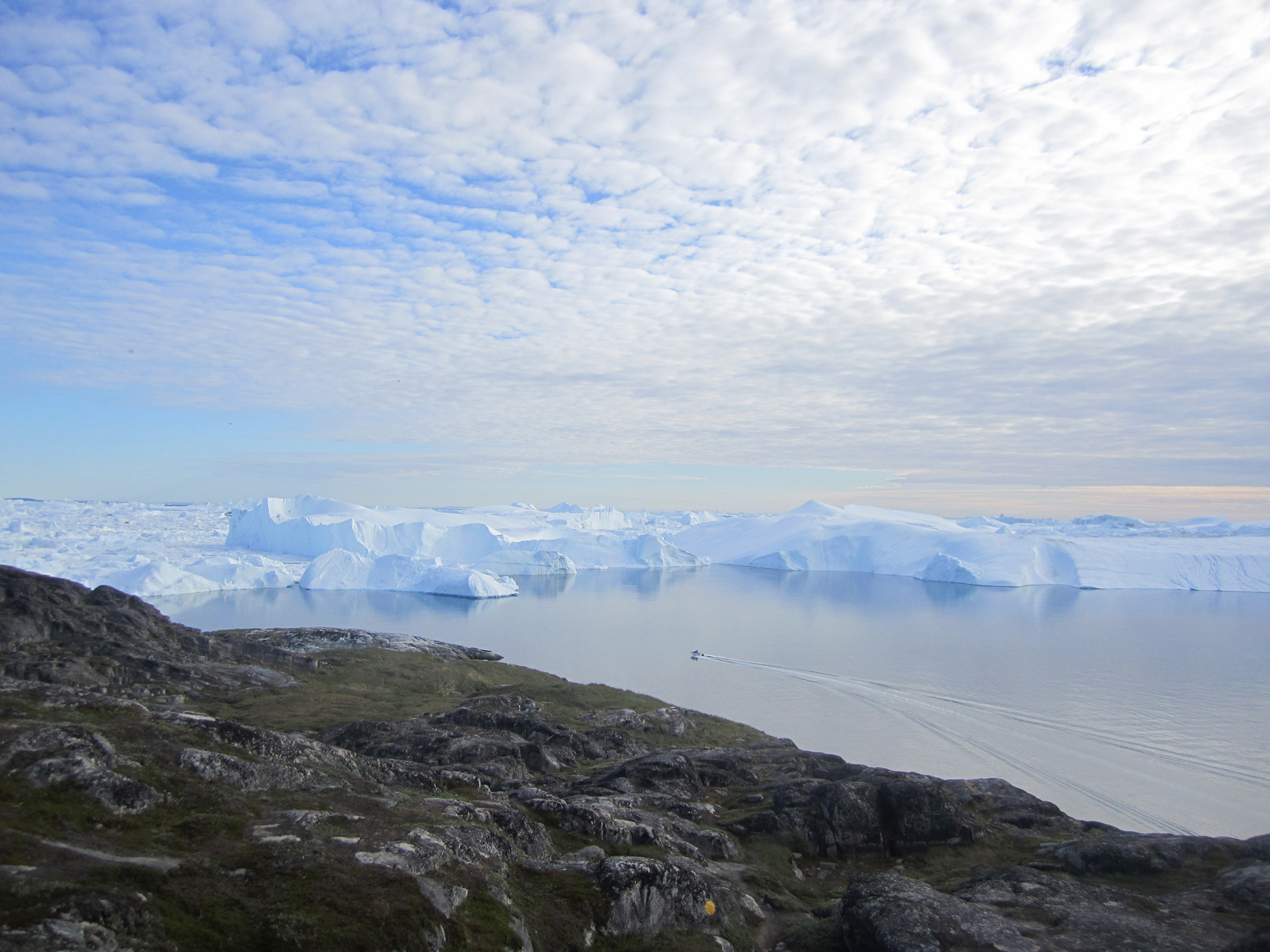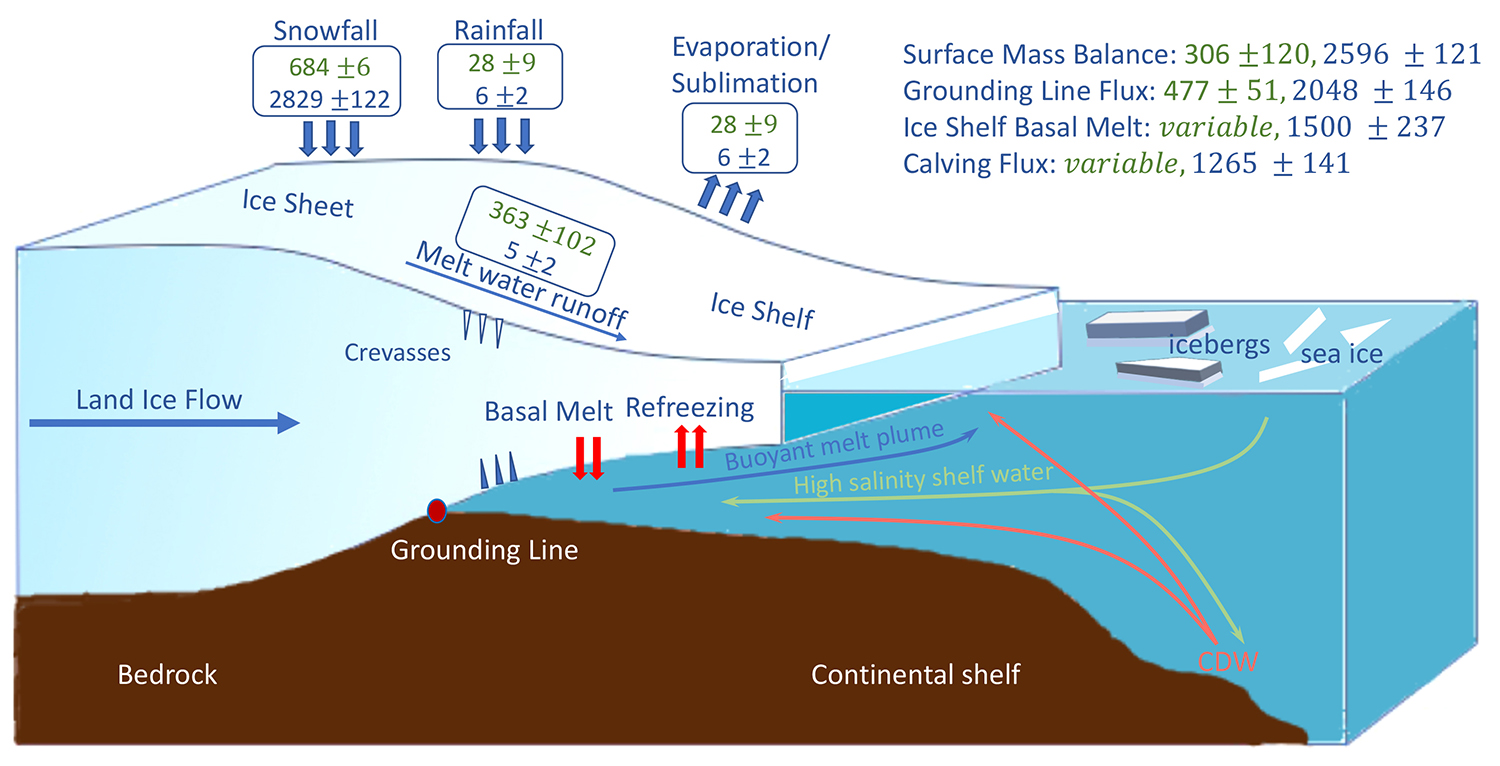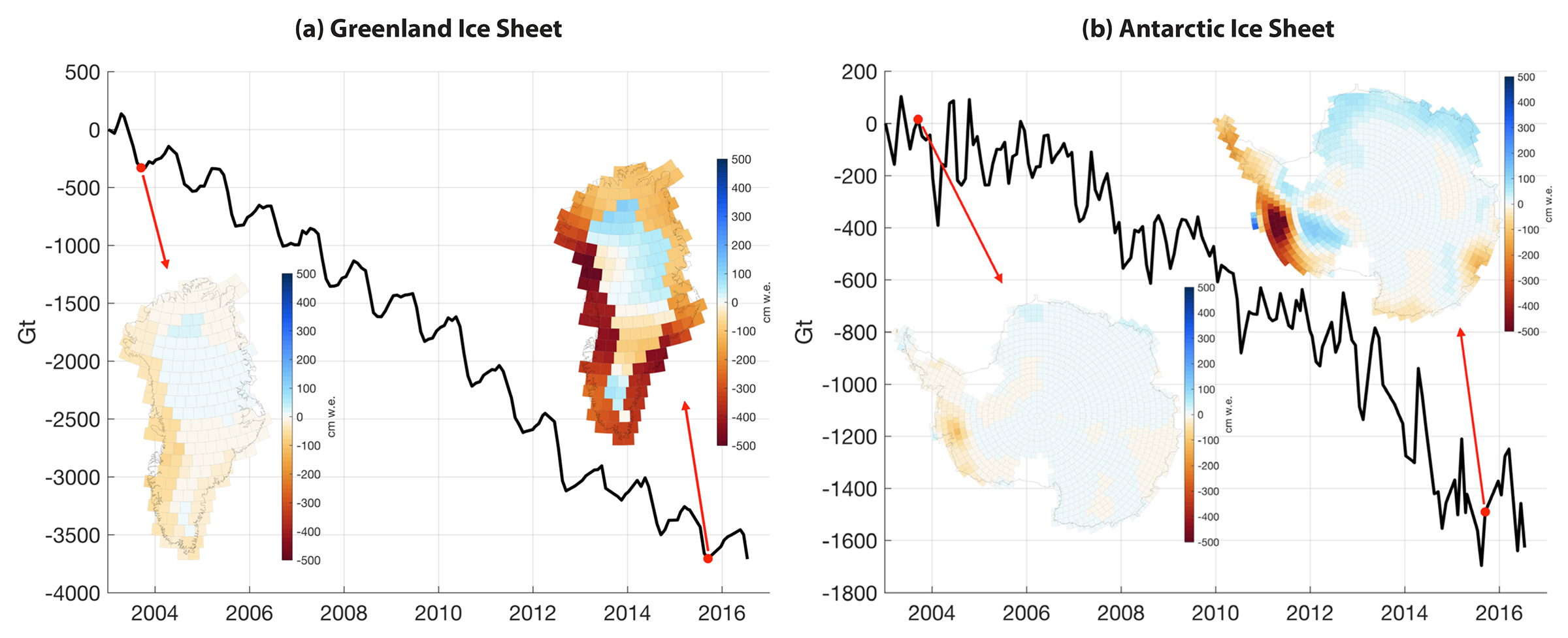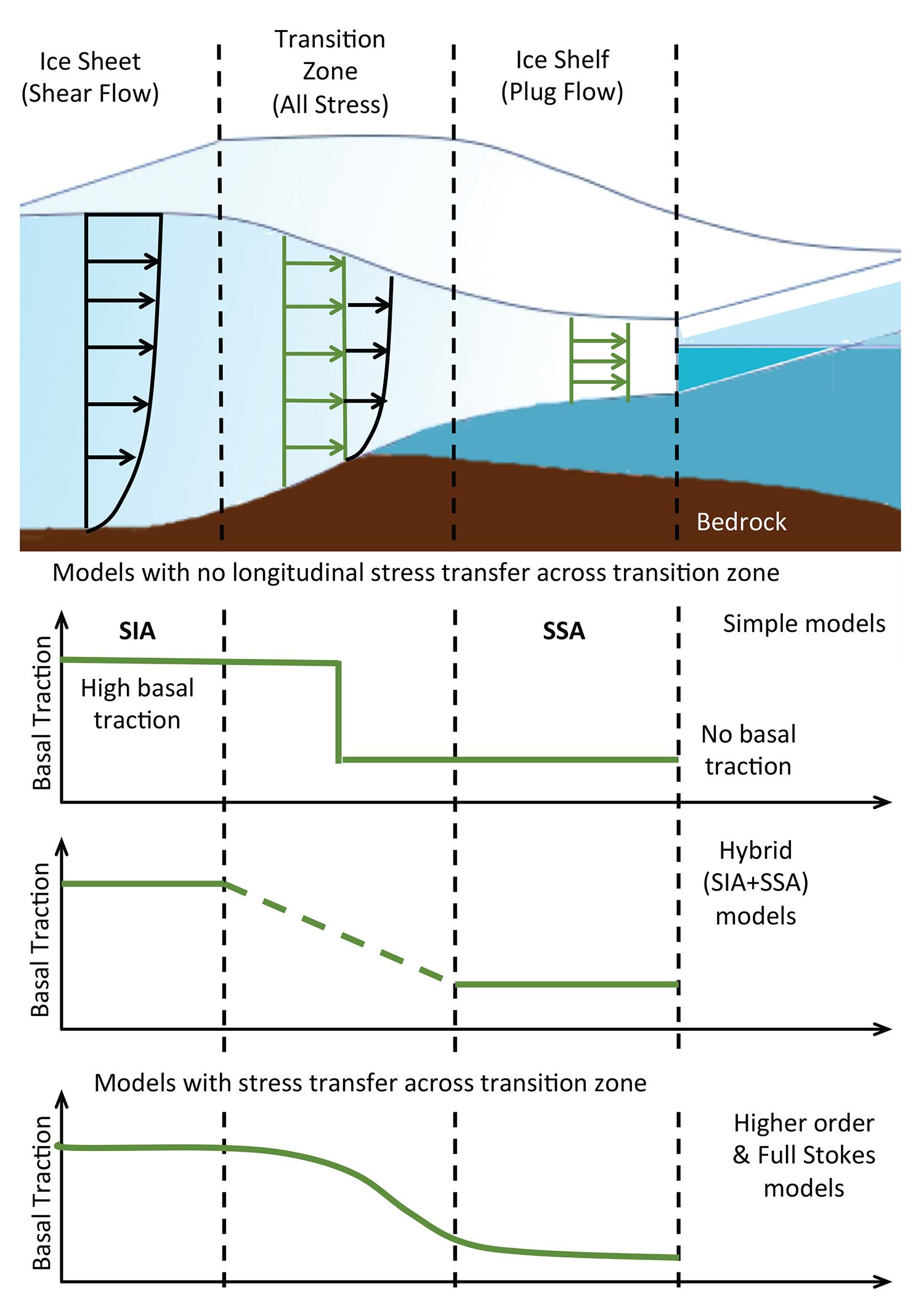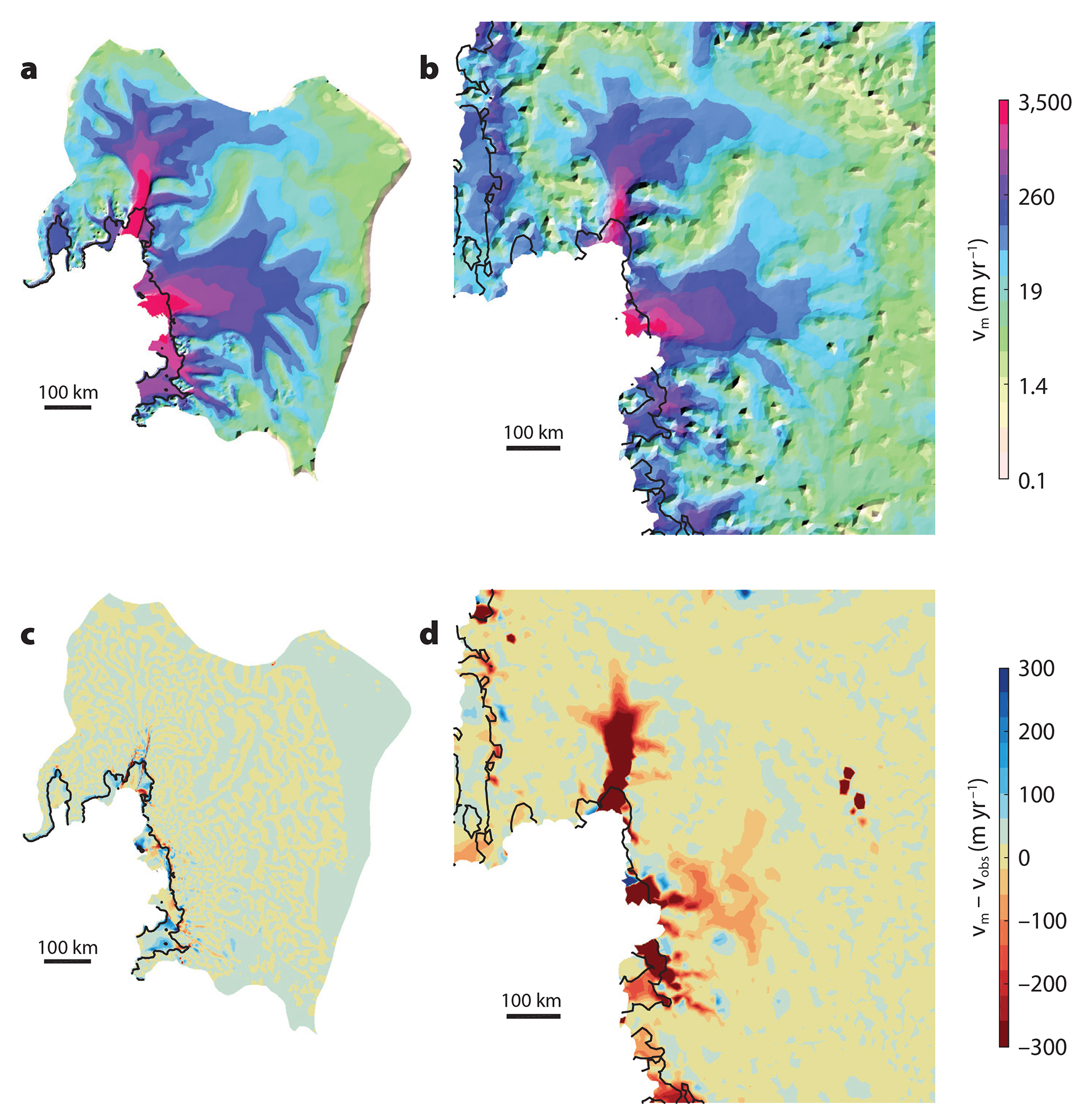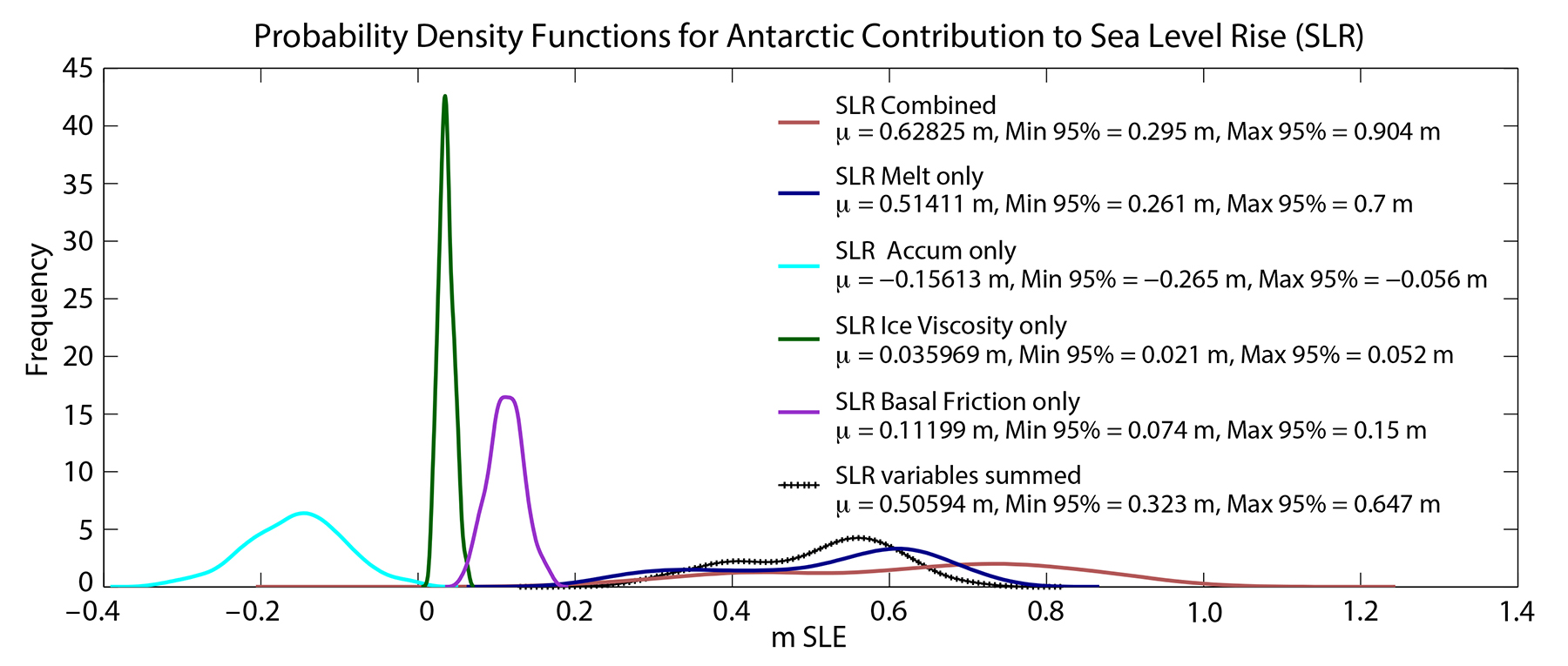Ahlkrona, J., P. Lotstedt, N. Kirchner, and T. Zwinger. 2016. Dynamically coupling the non-linear Stokes equations with the shallow ice approximation in glaciology: Description and first applications of the ISCAL method. Journal of Computational Physics 308, https://doi.org/10.1016/j.jcp.2015.12.025.
Albrecht, T., M. Martin, M. Haselo, R. Winkelmann, and A. Levermann. 2011. Parameterization for subgrid-scale motion of ice-shelf calving fronts. Cryosphere 5(1):35–44, https://doi.org/10.5194/tc-5-35-2011.
Alley, R., P. Clark, P. Huybrechts, and I. Joughin. 2005. Ice-sheet and sea-level changes. Science 310(5747):456–460, https://doi.org/10.1126/science.1114613.
Asay-Davis, X., S.L. Cornford, G. Durand, B.K. Galton-Fenzi, R.M. Gladstone, G.H. Gudmundsson, T. Hattermann, D.M. Holland, D. Holland, P.R. Holland, and others. 2016. Experimental design for three interrelated Marine Ice-Sheet and Ocean Model Intercomparison Projects: MISMIP v.3 (MISMIP+), ISOMIP v.2 (ISOMIP+) and MISOMIP v.1 (MISOMIP1). Geoscientific Model Development 9:2,471–2,497, https://doi.org/10.5194/gmd-9-2471-2016.
Asay-Davis, X.S., N.C. Jourdain, and Y. Nakayama. 2017. Developments in simulating and parameterizing interactions between the Southern Ocean and the Antarctic ice sheet. Current Climate Change Reports 3(4):316–329, https://doi.org/10.1007/s40641-017-0071-0.
Aschwanden, A., G. Adakgeirsdottir, and C. Khroulev. 2013. Hindcasting to measure ice sheet model sensitivity to initial states. Cryosphere 7(4):1,083–1,093, https://doi.org/10.5194/tc-7-1083-2013.
Bamber, J.L., J.A. Griggs, R.T.W.L. Hurkmans, J.A. Dowdeswell, S.P. Gogineni, I. Howat, J. Mouginot, J. Paden, S. Palmer, E. Rignot, and D. Steinhage. 2013. A new bed elevation dataset for Greenland. Cryosphere 7:499–510, https://doi.org/10.5194/tc-7-499-2013.
Benn, D.I., T. Cowton, J. Todd, and A. Luckman. 2017. Glacier calving in Greenland. Current Climate Change Reports 3:282–290, https://doi.org/10.1007/s40641-017-0070-1.
Berthier, E., T. Scambos, and C. Shuman. 2012. Mass loss of Larsen B tributary glaciers (Antarctic Peninsula) unabated since 2002. Geophysical Research Letters 39, L13501, https://doi.org/10.1029/2012GL051755.
Bondzio, J.H., M. Morlighem, H. Seroussi, T. Kleiner, M. Rückamp, J. Mouginot, T. Moon, E.Y. Larour, and A. Humbert. 2017. The mechanisms behind Jakobshavn Isbrea’s acceleration and mass loss: A 3-D thermomechanical model study. Geophysical Research Letters 44:6,252–6,260, https://doi.org/10.1002/2017GL073309.
Borstad, C., A. Khazendar, B. Scheuchl, M. Morlighem, E. Larour, and E. Rignot. 2016. A constitutive framework for predicting weakening and reduced buttressing of ice-shelves based on observations of the progressive deterioration of the remnant Larsen B ice shelf. Geophysical Research Letters 43(5):2,027–2,035, https://doi.org/10.1002/2015GL067365.
Christianson, K., B.R. Parizek, R.B. Alley, H.W. Horgan, R.W. Jacobel, S. Anandakrishnan, B.A. Keisling, B.D. Craig, and A. Muto. 2013. Ice sheet grounding zone stabilization due to till compaction. Geophysical Research Letters 40(20):5,406–5,411, https://doi.org/10.1002/2013gl057447.
Church, J.A., P.U. Clark, A. Cazenave, J.M. Gregory, S. Jevrejeva, A. Levermann, M.A. Merrifield, G.A. Milne, R.S. Nerem, P.D. Nunn, and others. 2013. Sea level change. Pp. 1,137–1,216 in Climate Change 2013: The Physical Science Basis. Contribution of Working Group I to the Fifth Assessment Report of the Intergovernmental Panel on Climate Change. T.F. Stocker, D. Qin, G.-K. Plattner, M. Tignor, S.K. Allen, J. Boschung, A. Nauels, Y. Xia, V. Bex, and P.M. Midgley, eds, Cambridge University Press, Cambridge, UK, and New York, NY, USA, https://doi.org/10.1017/CBO9781107415324.026.
Colloni, F., L. De Santis, C.S. Siddoway, A. Bergamasco, N.R. Golledge, G. Lohmann, S. Passchier, and M.J. Siegert. 2018. Spatio-temporal variability of processes across Antarctic ice-bed-ocean interfaces. Nature Communications 9(2289):2,041–1,723, https://doi.org/10.1038/s41467-018-04583-0.
Cornford, S.L., D.F. Martin, D.T. Graves, D.F. Ranken, A.M. Le Brocq, R.M. Gladstone, A.J. Payne, E.G. Ng, and W.H. Lipscomb. 2103. Adaptive mesh, finite volume modeling of marine ice-sheets. Journal of Computational Physics 232(1):529–549, https://doi.org/10.1016/j.jcp.2012.08.037.
Creyts, T.T., and C.G. Schoof. 2009. Drainage through subglacial water sheets. Journal of Geophysical Research 114:1–18, https://doi.org/10.1029/2008JF001215.
Csatho, B.M., A.F. Schenk, C.J. van der Veen, G. Babonis, K. Duncan, S. Rezvanbehbahani, M.R. van den Broeke, S.B. Simonsen, S. Nagarajan, and J.H. van Angelen. 2014. Laser altimetry reveals complex pattern of Greenland ice sheet dynamics. Proceedings of the National Academy of Sciences of the United States of America 111(52):18,478–18,483, https://doi.org/10.1073/pnas.1411680112.
Cuffey, K.M., and W.S.B Paterson. 2010. The Physics of Glaciers, 4th ed. Academic Press Amsterdam, 704 pp.
DeConto, R., and D. Pollard. 2016. Contribution of Antarctica to past and future sea-level rise. Nature 531:591–597, https://doi.org/10.1038/nature17145.
De Rydt, J., and G.H. Gudmundsson. 2016. Coupled ice shelf-ocean modeling and complex grounding line retreat from a seabed ridge. Journal of Geophysical Research 121:865–880, https://doi.org/10.1002/2015JF003791.
Durand, G., O. Gagliardini, B. de Fleurian, T. Zwinger, and E. Le Meur. 2009. Marine ice sheet dynamics: Hysteresis and neutral equilibrium. Journal of Geophysical Research 114, F03009, https://doi.org/10.1029/2008JF001170.
Dutton, A., A.E. Carlson, A.J. Long, G.A. Milne, P.U. Clark, R. DeConto, B.P. Horton, S. Rahmstorf, and M.E. Raymo. 2015. Sea-level rise due to polar ice-sheet mass loss during past warm periods. Science 349(6244):aaa4019, https://doi.org/10.1126/science.aaa4019.
Enderlin, E.M., I.M. Howat, S. Jeong, M.-J. Noh, J.H. van Angelen, and M.R. van den Broeke. 2014. An improved mass budget for the Greenland ice sheet. Geophysical Research Letters 41(3):866–872, https://doi.org/10.1002/2013GL059010.
Eyring, V., S. Bony, G.A. Meehl, C.A. Senior, B. Stevens, R.J. Stouffer, and K.E. Taylor. 2016. Overview of the coupled model intercomparison project phase 6 (CMIP6) experimental design and organization. Geoscientific Model Development 9(5):1,937–1,958, https://doi.org/10.5194/gmd-9-1937-2016.
Favier, L., G. Durand, S.L. Conford. G.H. Gudmundsson, O. Gagliardini, F. Gillet-Chaulet, T. Zwinger, A.J. Payne, and A.M. Le Brocq. 2014. Retreat of Pine Island Glacier controlled by marine ice-sheet instability. Nature Climate Change 4:117–121, https://doi.org/10.1038/NCLIMATE2094.
Favier, V., G. Krinner, C. Amory, H. Gallée, J. Beaumet, and C. Agosta. 2017. Antarctica-regional climate and surface mass budget. Current Climate Change Reports 3(4):303–315, https://doi.org/10.1007/s40641-017-0072-z.
Flato, G., J. Marotzke, B. Abiodun, P. Braconnot, S.C. Chou, W. Collins, P. Cox, F. Driouech, S. Emori, V. Eyring, and others. 2013. Evaluation of climate models. Pp. 741–866 in Climate Change 2013: The Physical Science Basis. Contribution of Working Group I to the Fifth Assessment Report of the Intergovernmental Panel on Climate Change. T.F. Stocker, D. Qin, G.-K. Plattner, M. Tignor, S.K. Allen, J. Boschung, A. Nauels, Y. Xia, V. Bex, and P.M. Midgley, eds, Cambridge University Press, Cambridge, UK, and New York, NY, USA, https://doi.org/10.1017/CBO9781107415324.020.
Fretwell, P., H.D. Pritchard, D.G. Vaughan, J.L. Bamber, N.E. Barrand, R. Bell, C. Bianchi, R.G. Bingham, D.D. Blankenship, G. Casassa, and others. 2013. Bedmap2: Improved ice bed, surface and thickness datasets for Antarctica. Cryosphere 7(1):375–393, https://doi.org/10.5194/tc-7-375-2013.
Fyke, J., O. Sergienko, M. Lofverstrom, S. Price, and J. Lenaerts. 2018. An overview of interactions and feedbacks between ice sheets and the Earth system. Reviews of Geophysics 56, https://doi.org/10.1029/2018RG000600.
Gillet-Chaulet, F., G. Durand, O. Gagliardini, C. Mosbeux, J. Mouginot, F. Rémy, and C. Ritz. 2016. Assimilation of surface velocities acquired between 1996 and 2010 to constrain the form of the basal friction law under Pine Island Glacier. Geophysical Research Letters 43:10,311–10,321, https://doi.org/10.1002/2016GL069937.
Goelzer, H., S. Nowicki, T. Edwards, M. Beckley, A. Abe-Ouchi, A. Aschwanden, R. Calov, O. Gagliardini, F. Gillet-Chaulet, N.R. Golledge, and others. 2018. Design and results of the ice sheet model initialisation experiments initMIP-Greenland: An ISMIP6 intercomparison. Cryosphere 12:1,433-1,460, https://doi.org/10.5194/tc-2017-129.
Goelzer, H., A. Robinson, H. Seroussi, and R.S.W. van de Wal. 2017. Recent progress in Greenland ice sheet modeling. Current Climate Change Reports 3(4):291–302, https://doi.org/10.1007/s40641-017-0073-y.
Goldberg, D.N., and P. Heimbach. 2013. Parameter and state estimation with a time-dependent adjoint marine ice sheet model. Cryosphere 17:1,659–1,678, https://doi.org/10.5194/tc-7-1659-2013.
Greene, C.A., D.D. Blankenship, D.E. Gwyther, A. Silvano, and E. van Wijk. 2017. Wind causes Totten Ice Shelf melt and acceleration. Science Advances 3(11):e1701681, https://doi.org/10.1126/sciadv.1701681.
Hutter, K. 1982. Dynamics of glaciers and large ice masses. Annual Review of Fluid Mechanics 14:87–130, https://doi.org/10.1146/annurev.fl.14.010182.000511.
Jacobs, S.S., A. Jenkins, C.F. Giulivi, and P. Dutrieux. 2011. Stronger ocean circulation and increased melting under Pine Island Glacier ice shelf. Nature Geosciences 4(8):519–523, https://doi.org/10.1038/NGEO1188.
Joughin, I., M. Fahnestock, D. MacAyeal, J. Bamber, and P. Gogineni. 2001. Observation and analysis of ice flow in the large Greenland ice stream. Journal of Geophysical Research 106(D24):34,021–34,034, https://doi.org/10.1029/2001JD900087.
Joughin, I., B. Smith, I. Howat, T. Scambos, and T. Moon. 2010. Greenland flow variability from ice-sheet-wide velocity mapping. Journal of Glaciology 56:416–430, https://doi.org/10.3189/002214310792447734.
Larour, E., H. Seroussi, M. Morlighem, and E. Rignot. 2012. Continental scale, high order, high spatial resolution, ice sheet modeling using the Ice Sheet System Model (ISSM). Journal of Geophysical Research 117, F01022, https://doi.org/10.1029/2011JF002140.
Larour, E., J. Utke, B. Csatho, A. Schenk, H. Seroussi, M. Morlighem, E. Rignot, N. Schlegel, and A. Khazendar. 2014. Inferred basal friction and surface mass balance of the Northeast Greenland Ice Stream using data assimilation of ICESat (Ice Cloud and land Elevation Satellite) surface altimetry and ISSM (Ice Sheet System Model). Cryosphere 8(6):2,335–2,351, https://doi.org/10.5194/tc-8-2335-2014.
Lenaerts, J., M. Vizcaino, J. Fyke, L. van Kampenhout, and M. van den Broeke. 2016. Present-day and future Antarctic ice sheet climate and surface mass balance in the Community Earth System Model. Climate Dynamics 5-6:1,367–1,381, https://doi.org/10.1007/s00382-015-2907-4.
MacAyeal, D.R. 1989. Large-scale ice flow over a viscous basal sediment: Theory and application to Ice Stream B, Antarctica. Journal of Geophysical Research 94(B4):4,071–4,087, https://doi.org/10.1029/JB094iB04p04071.
MacAyeal, D.R. 1992. The basal stress distribution of Ice Stream E, Antarctica, inferred by control methods. Journal of Geophysical Research 97(B1):595–603, https://doi.org/10.1029/91JB02454.
Martin, M.A., R. Winkelmann, M. Haseloff, T. Albrecht, E. Bueler, C. Khroulev, and A. Levermann. 2011. The Potsdam Parallel Ice Sheet Model (PISM-PIK): Part 2. Dynamic equilibrium simulation of the Antarctic ice sheet. Cryosphere 5(3):727–740, https://doi.org/10.5194/tc-5-727-2011.
Meehl, G.A., T.F. Stocker, W.D. Collins, P. Friedlingstein, A.T. Gaye, J.M. Gregory, A. Kitoh, R. Knutti, J.M. Murphy, A. Noda, and others. 2007. Global climate projections. Pp. 747–845 in Climate Change 2007: The Physical Science Basis. Contribution of Working Group I to the Fourth Assessment Report of the Intergovernmental Panel on Climate Change. S. Solomon, D. Qin, M. Manning, Z. Chen, M. Marquis, K.B. Averyt, M. Tignor, and H.L. Miller, eds, Cambridge University Press, Cambridge, UK, and New York, NY, USA.
Menemenlis, D., J.-M. Campin, P. Heimbach, C. Hill, T. Lee, A. Nguyen, M. Schodlok, and H. Zhang. 2008. ECCO 2: High resolution global ocean and sea ice data synthesis. Mercator Ocean Quarternary Newsletter 31:13–21.
Milillo, P., E. Rignot, J. Mouginot, B. Scheuchl, M. Morlighem, X. Li, and J.T. Salzer. 2017. On the short-term grounding zone dynamics of Pine Island glacier, West Antarctica, observed with COSMO-SkyMed interferometric data. Geophysical Research Letters 44:10,436–10,444, https://doi.org/10.1002/2017GL074320.
Moon, T., I. Joughin, B. Smith, and I. Howat. 2012. 21st-century evolution of Greenland outlet glacier velocities. Science 336(6081):576–578, https://doi.org/10.1126/science.1219985.
Morlighem, M., E. Rignot, J. Mouginot, H. Seroussi, and E. Larour. 2014. High-resolution ice thickness mapping in South Greenland. Annals of Glaciology 55(67):64–70, https://doi.org/10.3189/2014AoG67A088.
Morlighem, M., E. Rignot, H. Seroussi, E. Larour, H.B. Dhia, and D. Aubry. 2010. Spatial patterns of basal drag inferred using control methods from a full-Stokes and simpler models for Pine Island Glacier, West Antarctica. Geophysical Research Letters 37, L14502, https://doi.org/10.1029/2010GL043853.
Morlighem, M., E. Rignot, H. Seroussi, E. Larour, H.B. Dhia, and D. Aubry. 2011. A mass conservation approach for mapping glacier ice thickness. Geophysical Research Letters 38, L19503, https://doi.org/10.1029/2011GL048659.
Mouginot, J., E. Rignot, and B. Scheuchl. 2014. Sustained increase in ice discharge from the Amundsen Sea embayment, West Antarctica, from 1973 to 2013. Geophysical Research Letters 41:1–9, https://doi.org/10.1002/2013GL059069.
Nowicki, S., R.A. Bindschadler, A. Abe-Ouchi, A. Aschwanden, E. Bueier, H. Choi, J. Fastook, G. Granzow, R. Greve, G. Gutowski, and others. 2013. Insights into spatial sensitivities of ice mass response to environmental change from the SeaRISE ice sheet modeling project I: Antarctica. Journal of Geophysical Research 118:1,002–1,024, https://doi.org/10.1002/jgrf.20081.
Nowicki, S.M.J., A. Payne, E. Larour, H. Seroussi, H. Goelzer, W. Lipscomb, J. Gregory, A. Abe-Ouchi, and A. Shepherd. 2016. Ice Sheet Model Intercomparison Project (ISMIP6) contribution to CMIP6. Geoscientific Model Development 9:4,521–4,545, https://doi.org/10.5194/gmd-9-4521-2016.
Nowicki, S., and D.J. Wingham. 2008. Conditions for a steady ice sheet-ice shelf junction. Earth and Planetary Science Letters 265(1-2):246–255, https://doi.org/10.1016/j.epsl.2007.10.018.
Padman, L., M.R. Siegert, and H.A. Fricker. 2018. Ocean tide influences on the Antarctic and Greenland ice sheets. Reviews of Geophysics 56, https://doi.org/10.1002/2016RG000546.
Pattyn, F., 2003. A new three-dimensional higher-order thermomechanical ice sheet model: Basic sensitivity, ice stream development, and ice flow across subglacial lakes. Journal of Geophysical Research 108(B8), https://doi.org/10.1029/2002JB002329.
Pattyn, F., L. Favier, S. Sun, and G. Durand. 2017. Progress in numerical modeling of Antarctic ice-sheet dynamics. Current Climate Change Reports 3(4):174–184, https://doi.org/10.1007/s40641-017-0069-7.
Pattyn, F., A. Huyghe, S. De Brabander, and B. De Smedt. 2006. Role of transition zones in marine ice sheet dynamics. Journal of Geophysical Research 111(F2):1–10, https://doi.org/10.1029/2005JF000394.
Pattyn, F., L. Perichon, G. Durand, and L. Favier. 2013. Grounding-line migration in plan-view marine ice-sheet models: Results of the ice2sea MISMIP3d intercomparison. Journal of Glaciology 59(215):410–422, https://doi.org/10.3189/2013JoG12J129.
Pattyn, F., C. Schoof, L. Perichon, R.C.A. Hindmarsh, E. Bueler, B. de Fleurian, G. Durand, O. Gagliardini, R. Gladstone, D. Goldberg, and others. 2012. Results of the Marine Ice Sheet Model Intercomparison Project, MISMIP. Cryosphere 6(3):573–588, https://doi.org/10.5194/tc-6-573-2012.
Phillips, T., H. Rajaram, and K. Steffen. 2010. Cryo-hydrologic warming: A potential mechanism for rapid thermal response of ice sheets. Geophysical Research Letters 7:1–5, https://doi.org/10.1029/2010GL044397.
Pollard, D., and R.M. DeConto. 2012. A simple inverse method for the distribution of basal sliding coefficients under ice sheets, applied to Antarctica. Cryosphere 6(5):953–971, https://doi.org/10.5194/tc-6-953-2012.
Pralong, A., and M. Funk. 2004. A level-set method for modeling the evolution of glacier geometry. Journal of Glaciology 50(171):485–491, https://doi.org/10.3189/172756504781829774.
Pritchard, H., R. Arthern, D. Vaughan, and L. Edwards. 2009. Extensive dynamic thinning on the margins of the Greenland and Antarctic ice sheets. Nature 461:971–975, https://doi.org/10.1038/nature08471.
Rahmstorf, S. 2002. Ocean circulation and climate during the past 120,000 years. Nature 419:207–214, https://doi.org/10.1038/nature01090.
Retzlaff, R., and C. Bentley. 1993. Timing of stagnation of Ice Stream C, West Antarctica, from short-pulse radar studies of buried surface crevasses. Journal of Glaciology 39(133):553–561, https://doi.org/10.3189/S0022143000016440.
Rignot, E. 1998. Fast recession of a West Antarctic glacier. Science 281(5376):549–551, https://doi.org/10.1126/science.281.5376.549.
Rignot, E., J.L. Bamber. M.R. van den Broeke, C. Davis, Y. Li, W.J. van de Berg, and E. van Meijgaard. 2008. Recent Antarctic ice mass loss from radar interferometry and regional climate modeling. Nature Geoscience 1(2):106–110, https://doi.org/10.1038/ngeo102.
Rignot, E., S. Jacobs, J. Mouginot, and B. Scheuchl. 2013. Ice-shelf melting around Antarctica. Science 341(6143):266–270, https://doi.org/10.1126/science.1235798.
Rignot, E., I. Velicogna, M. van den Broeke, A. Monaghan, and J. Lenaerts. 2011. Acceleration of the contribution of the Greenland and Antarctic ice sheets to sea-level rise. Geophysical Research Letters 38:1–5, https://doi.org/10.1029/2011GL046583.
Ritz, C., T.L. Edwards, G. Durand, A.J. Payne, V. Peyaud, and R.C.A. Hindmarsh. 2015. Potential sea-level rise from Antarctic ice-sheet instability constrained by observations. Nature 528(7580):1150118, https://doi.org/10.1038/nature16147.
Schlegel, N., H. Seroussi, M.P. Schodlok, E.Y. Larour, C. Boening, D. Limonadi, M.M. Watkins, M. Morlighem, and M.R. van den Broeke. 2018. Exploration of the Antarctic ice-sheet 100-year contribution to sea level rise and associated model uncertainties using the ISSM framework. The Cryosphere Discussions, https://doi.org/10.5194/tc-2018-105.
Schoof, C. 2007. Ice sheet grounding line dynamics: Steady states, stability, and hysteresis. Journal of Geophysical Research 112, F03S28, https://doi.org/10.1029/2006JF000664.
Schoof, C., and R.C.A. Hindmarsh, 2010. Thin-film flows with wall slip: An asymptotic analysis of higher order glacier flow models. Quarternary Journal of Mechanics and Applied Mathematics 63:73–114, https://doi.org/10.1093/qjmam/hbp025.
Seroussi, H., H.B. Dhia, M. Morlighem, E. Larour, E. Rignot, and D. Aubry. 2012. Coupling ice flow models of varying order of complexity with the Tiling Method. Journal of Glaciology 58(210):776–786, https://doi.org/10.3189/2012JoG11J195.
Seroussi, H., M. Morlighem, E. Larour, E. Rignot, and A. Khazendar. 2014. Hydrostatic grounding line parameterization in ice-sheet models. Cryosphere 8(6):2,075–2,087, https://doi.org/10.5194/tc-8-2075-2014.
Seroussi, H., M. Morlighem, E. Rignot, E. Larour, D. Aubry, H.B. Dhia, and S.S. Kristensen. 2011. Ice flux divergence anomalies on 79north Glacier, Greenland. Geophysical Research Letters 38, L09501, https://doi.org/10.1029/2011GL047338.
Seroussi, H., Y. Nakayama, E. Larour, D. Menemenlis, M. Morlighem, E. Rignot, and A. Khazendar. 2017. Continued retreat of Thwaites Glacier, West Antarctica, controlled by bed topography and ocean circulation. Geophysical Research Letters 44:6,191–6,199, https://doi.org/10.1002/2017GL072910.
Shepherd, A., E.R. Ivins, A. Geruo, V.R. Barletta, M.J. Bentley, S. Bettadpur, K.H. Briggs, D.H. Bromwich, R. Forsberg, N. Galin, and others. 2012. A reconciled estimate of ice-sheet mass balance. Science 338(6111):1,183–1,189, https://doi.org/10.1126/science.1228102.
Shepherd, A., E. Ivins, E. Rignot, B. Smith, M. van den Broeke, I. Velicogna, P. Whitehouse, K. Briggs, I. Joughin, G. Krinner, and others. 2018. Mass balance of the Antarctic Ice Sheet from 1992 to 2017. Nature 558:219–222, https://doi.org/10.1038/s41586-018-0179-y.
Shepherd, A., and S. Nowicki. 2017. Improvements in ice-sheet sea-level projections. Nature Climate Change 7:672–674, https://doi.org/10.1038/nclimate3400.
Steig, E.J., Q. Ding, D.S. Battisti, and A. Jenkins. 2012. Tropical forcing of Circumpolar Deep Water inflow and outlet glacier thinning in the Amundsen Sea Embayment, West Antarctica. Annals of Glaciology 53(60), https://doi.org/10.3189/2012AoG60A110.
Straneo, F. 2013. Challenges to understanding the dynamic response of Greenland’s marine terminating glaciers to oceanic and atmospheric forcing. Bulletin of the American Meteorological Society 94(8):1,131–1,144, https://doi.org/10.1175/BAMS-D-12-00100.1.
Strauss, B.H., S. Kulp, and A. Levermann. 2015. Carbon choices determine US cities committed to futures below sea level. Proceedings of the National Academy of Sciences of the United States of America 112(44):13,508–13,513, https://doi.org/10.1073/pnas.1511186112.
van den Broeke, J. Box, X. Fettweis, E. Hanna, B. Noël, M. Tedesco, D. van As, W.J. van de Berg, and L. van Kampenhout. 2017. Greenland ice sheet surface mass loss: Recent developments in observation and modeling. Current Climate Change Reports 3(4):345–356, https://doi.org/10.1007/s40641-017-0084-8.
van den Broeke, E.M. Enderlin, I.M. Howat, P. Kuipers Munneke, B.P.Y. Noël, W.J. van de Berg, E. van Meijgaard, and B. Wouters. 2016. On the recent contribution of the Greenland ice sheet to sea level change. Cryosphere 10:1,933–1,946, https://doi.org/10.5194/tc-10-1933-2016.
Vizcaino, M., W.H. Lipscomb, W.J. Sacks, and M. van den Broeke. 2013. Greenland surface mass balance as simulated by the Community Earth System Model: Part II. 21st century changes. Journal of Climate 27:215–226, https://doi.org/10.1175/jcli-d-12-00588.1.
Vizcaino, M., W. Mikolajawicz, F. Ziemen, C.B. Rodehacke, R. Greve, and M.R. van den Broeke. 2015. Coupled simulations of Greenland ice sheet and climate change up to A.D. 2300. Geophysical Research Letters 42:3,927–3,935, https://doi.org/10.1002/2014GL061142.
Warrick, R.A., C. Le Provost, M.F. Meier, J. Oerlemans, R.B. Alley, R.A. Bindschadler, C.R. Bentley, R.J. Braithwaite, J.R. de Wolde, B.C. Douglas, and others. 1996. Changes in sea level. Pp. 359–405 in Climate Change 1995: The Science of Climate Change. Contribution of WGI to the Second Assessment Report of the Intergovernmental Panel on Climate Change, J.T. Houghton, L.G. Meira Filho, B.A. Callander, N. Harris, A. Kattenberg, and K. Maskell, eds, Cambridge University Press.
Warrick, R.A., J. Oerlemans, P. Beaumont, R.J. Braithwaite, D.J. Drewery, V. Gornitz, J.M. Grove, W. Haeberli, A. Higasi, J.C. Leiva, and others. 1990. Sea level rise. Pp. 257–282 in Climate Change: The IPCC Scientific Assessment. J.T. Houghton, G.J. Jenkins, and J.J. Ephraums, eds, Cambridge University Press.
Whillans, I.M., and C. van der Veen. 1993. Patterns of calculated basal drag on ice streams B and C, Antarctica. Journal of Glaciology 39(133):437–446,
https://doi.org/10.3189/S0022143000016324.
Willis, J.K., D. Carroll, I. Fenty, G. Kohli, A. Khazendar, M. Rutherford, N. Trenholm, and M. Morlighem. 2018. Ocean-ice interactions in Inglefield Gulf: Early results from NASA’s Oceans Melting Greenland mission. Oceanography 31(2), https://doi.org/10.5670/oceanog.2018.211.


